Buckthorn, and what to do about it
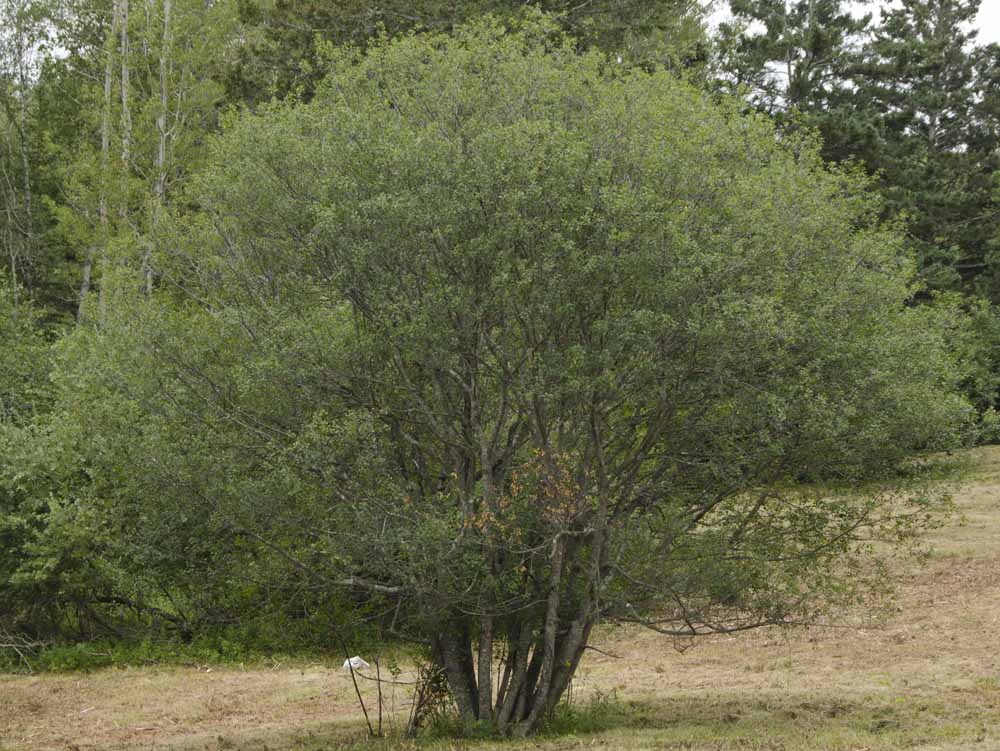
Like the soft snails that have suddenly appeared in our gardens, buckthorn crept in quietly. At first, few people noticed; those who did saw a small, vigorous tree or shrub with glossy green leaves and lovely red-purple berries that attract birds. Even as buckthorn began to conquer whole properties, and suffocate every other plant, it maintained an innocuous, attractive appearance. Mowers deliberately spared the seedlings, and gardeners pruned large specimens conscientiously.
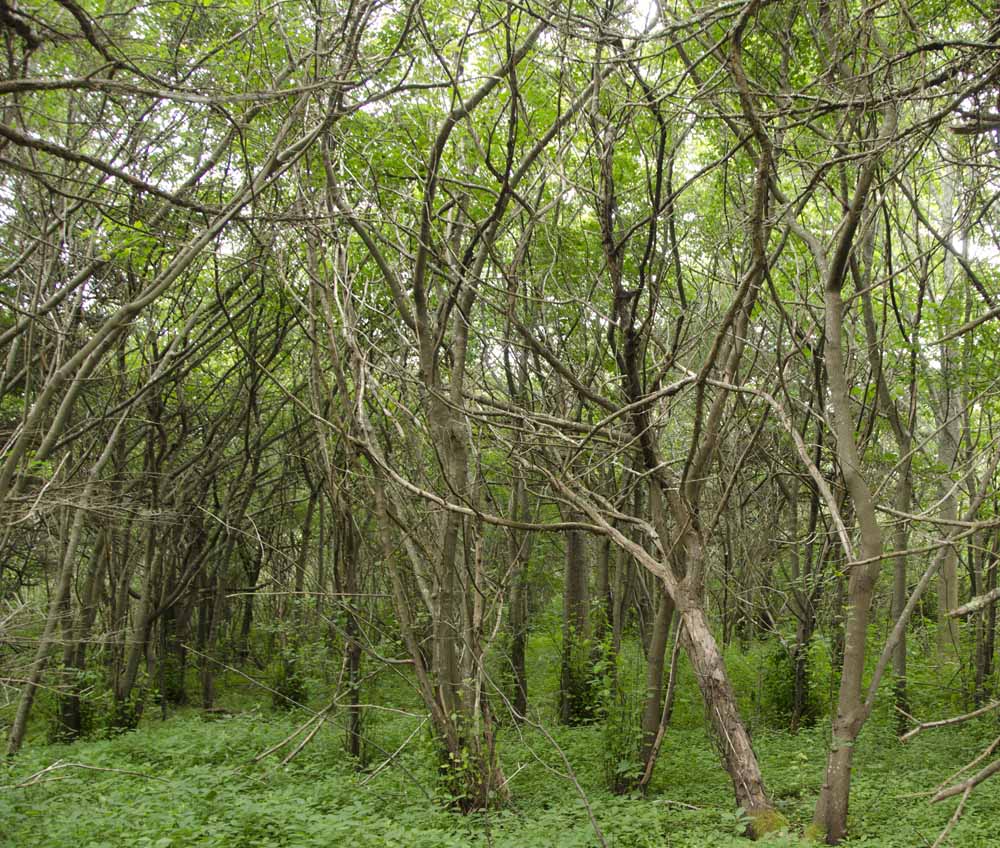
Of European origin, buckthorn (Rhamnus cathartica) has long been naturalized in North America. Still uncommon on the mainland, buckthorn has become a terrible infestation on North Haven. It threatens the diversity of our landscape, and it will probably be impossible to eradicate. Tough, persistent, and fast-growing (3-4 feet/year), it was once favored by landscapers, and there is even a “national champion” tree, 61' tall, in Michigan. An isolated buckthorn assumes a habit as wide as it is tall, usually in the 15-25' range, and surrounded by its own children; but commonly it grows in increasingly crowded thickets, where competition for light produces tall slender individuals up to 35'. One mature buckthorn may produce a million seeds, but the berries that ripen in August have scant nutritional value. Migratory birds that bulk up on buckthorn are said to plummet into the sea halfway to their destination, out of gas. Deer and mouflon regurgitate the berries; true to its name, the fruit is cathartic.
I’ve been battling buckthorn for 20 years. To get rid of them, I’ve tried every conceivable method short of burning — and, note well, simple strategies (like cutting them down) do NOT work. This is a guide to eliminating (or at least controlling) them, based on trial and lots of error.
Identification
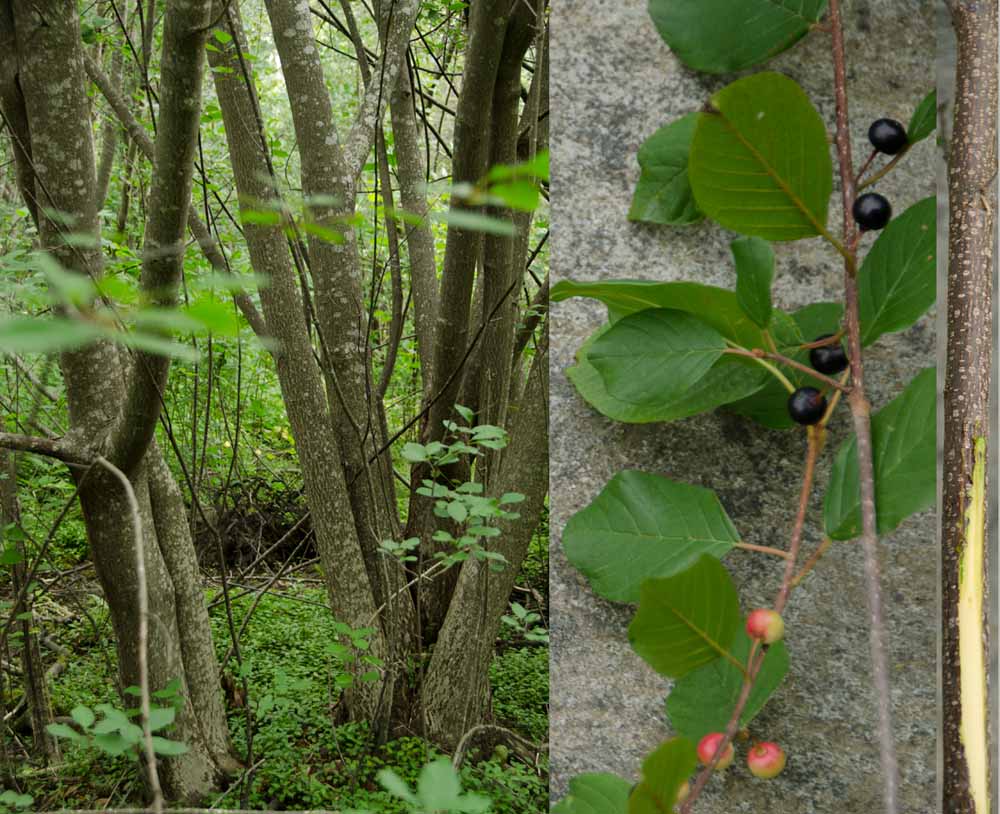
Wood: Usually single-stem (single trunk or main leader); secondary regrowth from roots (after being cut down) is multi-stemmed. Brown speckled bark with elongate silvery corky projections [caution: wild cherry has similar bark — but it’s a weed too!]. Stripped bark exposes yellow sapwood; cut branch exposes orange heartwood.
Branch: Buds and leaves are alternate.
Leaves: Egg-shaped, pointed at the tip, smooth, dark, glossy, with smooth (untoothed) perimeter [cherry is toothed]. 3-5 pairs of alternate, curved leaf veins that often look nearly opposite. Leaves stay green into October.
Fruit: Clusters of round, berry-like ¼" fruits, first green, then red, and finally ripening to purple-black in August.
The Secret
The key to killing buckthorn is removal of the entire plant, root and branch. Grab the main leader(s) near the ground, where the leader is strongest, and pull the plant slowly out of the ground, either manually or with a machine, so that the entire root system is unearthed. If significant rootstock remains in the ground, the plant will grow back, guaranteed.
What NOT to do
NEVER saw the plant off at ground level, because next year, instead of a single leader, you’ll see 10-15 tender sports arise around the base, much too weak (individually or altogether) to serve as a “handle” to withdraw the remaining (and substantial) root system underground. In short, if you cut the plant down at ground level, you’ve destroyed your option to ever yank the rootball out, and your sole recourse will be to dig it out, with a shovel or back hoe. Heavy-duty bush hogs can rapidly flatten groves of young buckthorn up to about 3" girth at the base. But bush hogs destroy everything: fern, wild orchid, young maple, ash, and oak — the plants you might prefer to foster. Think carefully about the longterm result you want (and also feasibility — you can’t mow ledge, boulders, uneven ground, big spruce, stumps, etc., the very places buckthorn tend to haunt).
Cutting down the entire plant is an irreversible mistake UNLESS you intend to mow annually in future, to perpetually maintain a clear-cut field. Annual (or, at minimum, biennial) mowing means that buckthorn will never bear fruit again — preventing fruiting is the uppermost priority in buckthorn eradication. Annual mowing will eventually kill some, but not all, plants.
Round-Up may appear to kill buckthorn for one or two seasons, but eventually they rebound, with roots more vigorous than ever, and the same problem of multiple weak stems that break when pulled. (Round-Up has alleged human health consequences, too.)
Manual removal
Most easily done in the early spring, before hair roots “lock” buckthorn into the ground, or in late fall after hair roots die. You have a 2-3 week window of opportunity, in early April or November. Young plants less than 3-4' tall will usually slide out of the ground with astonishing ease (try again after root hairs develop, and the same plant may withstand four strong arms and backbreaking tugs).
Larger plants, up to 7-8', will probably require a tool, like the medium- or large-size Weed Wrench ($155-190), which really works. (Note that the large Weed Wrench is heavy and tiring to carry in the field, although it can remove quite large plants, even in midsummer.)
Plants above about 8' pose real problems, and generally require the eventual intervention of machines (a winch, back hoe, or excavator). An ad hoc strategy (or if you have no access to machinery) is to saw the plant off just below the lowest branch, about 2-3' above the ground (I often do this in early summer, to prevent a mature buckthorn from fruiting, knowing that I will return later with equipment to remove the roots): in my experience, about 30-40% of plants of all sizes are “tricked” thereby into pushing energy and nutrients up this dead-end main leader instead of growing new sports at the base, and eventually the plant may exhaust itself and die; if not, you’ve still weakened the plant considerably, it won’t be able fruit again for about 3 years, and above all you’ve left a strong leader which is distinctively identifiable in the field, and for a year or two (until it rots) will offer a “handle” strong enough to withdraw the root system from the ground.
If you do not intend to remove large roots mechanically, your primary task must be to prevent fruiting, which generates thousands of seedlings. Repeatedly saw off all growth except for the truncated stalk of the main leader (as above). Do not allow any leaves to develop. Eventually the plant will die from lack of photosynthesis, but it may take years. With a large buckthorn infestation, anticipate incessant pruning and leaf removal.
Mechanical removal
Winching is the easiest way to remove all but the very largest buckthorn (above 20'). Wrap the chain around the base of the main leader twice, tighten the cinch manually, then winch slowly. Two laborers — one cinching, the other operating the winch — can easily remove hundreds of substantial plants per day. Unfortunately, most plants that require winching are already mature, and have fruited many times; hundreds or thousands of little buckthorn will spring up nearby, especially after the parent’s shadow is removed and the children are exposed to light. Yank these children manually before they can fruit. If they are less than one year old, you’ll probably find that you can pull them with relative ease in any frost-free season.
A back hoe or excavator is probably the only solution for forests of large buckthorn, such as occur all along the North Shore. It is sobering to try to walk through one of these almost impenetrable thickets, e.g. west of the Town Dump. Every other species is choked out; the girth of some buckthorn at the base reaches 12-24 inches. Costly though it might be undertake removal with heavy equipment, in the long run you’ll spare yourself huge effort — and you’ll still be busy, because small buckthorn will abound after the land is cleared: the seeds remain viable for many years.
The sooner we tackle our buckthorn problem, the more likely our chance to bring it under control, or at least curb its progress. This unwelcome, daunting burden rests most heavily on lands with untended areas, especially clearcuts and blowdown wastelands, which create ideal arenas for an opportunistic plant that grows faster than all others. If we do nothing, we face an ecological catastrophe. I am not optimistic: most landowners lack the awareness, will, time, manpower, and/or machinery to effectively address the issue, and many parcels are already so densely infested that the task seems hopeless.
Yearlings like these . . .
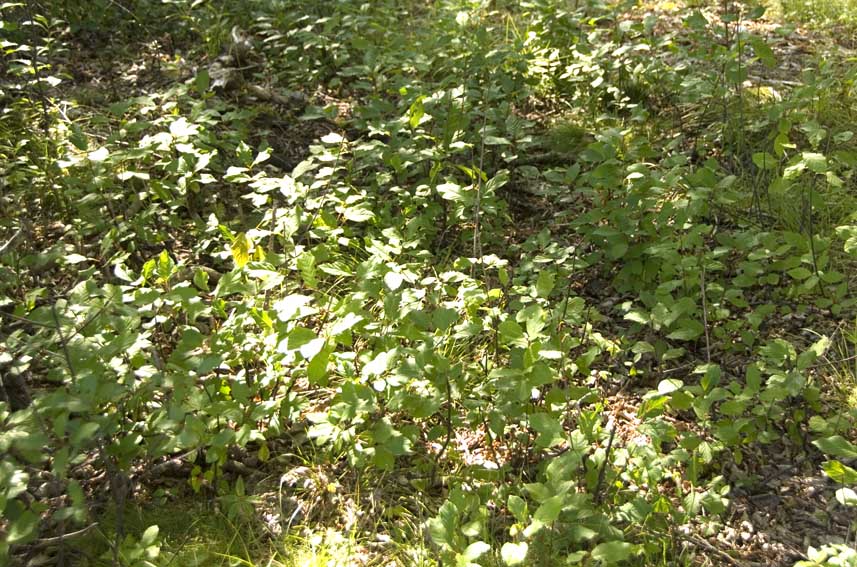
. . . become youngsters like these . . .
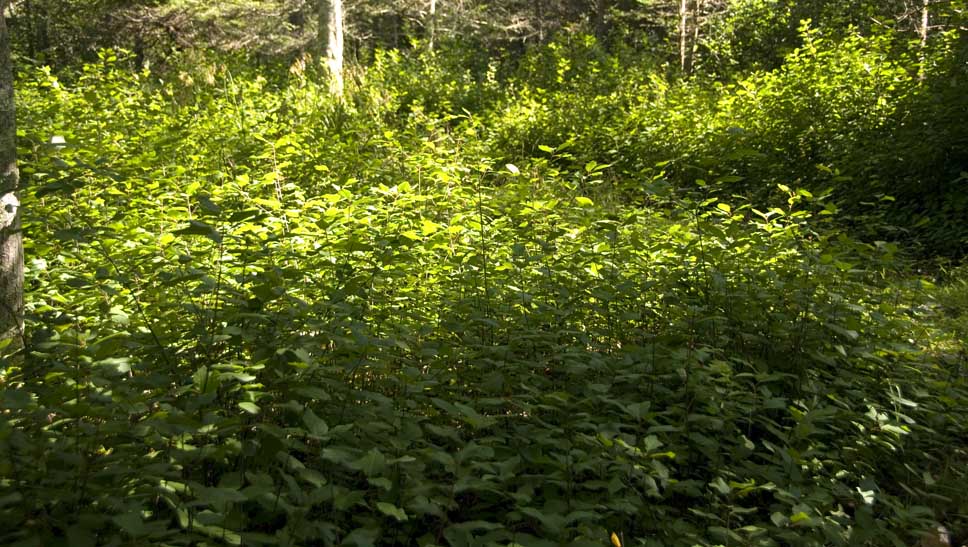
. . . and within 10 years, a single-species forest.

Jeff Holmgren rjholmgren@gmail.com LastRev.28 Aug 2011





